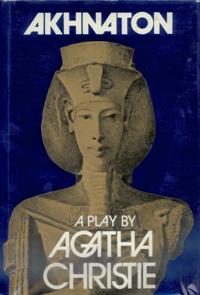As you might expect from the striking front cover and title, this is something a bit different. In fact, I'd probably never read it if it wasn't for Agatha-Christie-devouring completeness.
It's a historical play (so not a murder mystery) set in Ancient Egypt. It's never been properly performed however (though she must have liked it to want it published), and has 'little commercial value', apparently. Which I read as code for being 'utterly boring'.
But whilst it's not boring, it is a bit dry. You don't need too much background knowledge when reading it - entry level Egyptology will suffice' - but the play concerns the reign of the pharoah Akhnaton (whose wife Neferiti was probably more famous, as was his successor Tutankhamun), and his subsequent downfall. The play wobbles between historical background and research (names of gods, practices, lineage and castes, especially apparent in long speeches) with typical human drama and emotion (idle talk between townsfolk, many of the characters' conversations). It's melodramatic, and more highbrow than your usual fare.
But altogether, it hangs together quite nicely. For its big scale and subject matter (there's many sets and costumes, and always talk of far off rebellion) it wrings every bit of human drama out of the royal court, with the mad king (which felt a bit Shakespearean, but it works), his right-hand-man, and plots against him by priests and saboteurs. He was the king who shook off using multiple religious gods, instead reverting to one, represented by the sun. Agatha paints him as young, artistic and peace loving, ambitious but weak and misguided, and ultimately very very mad. So that's fairly hard to warm to, when your main character goes off on one at the end of the scene.
Whilst it's nowhere near the usual Agatha Christie in subject matter (despite her referring to history and archaeology many times), somehow in places characters end up talking very much like Agatha Christie characters, circa 1937 when it was written (seriously, the discussions about the nature of art could come straight from Five Little Pigs or The Hollow).
Its main feat is creating an actual readable (or performable) play out of such a sparse, yet rich, strain of history. It's worth noting that, as it was written in 1937, much of the historical 'accuracy' has been disproved by now, or even by 1973 when the book was published. It was only written fifteen years after Howard Carter discovered Tutankhamun's tomb. However, given the historically dry subject matter, to experts and non-experts alike, her later Ancient Egyptian murder mystery Death Comes As The End is probably a safer, more mainstream choice.


No comments:
Post a Comment